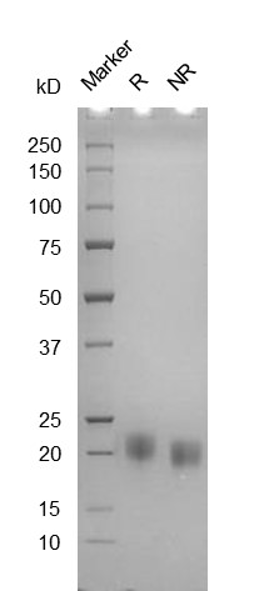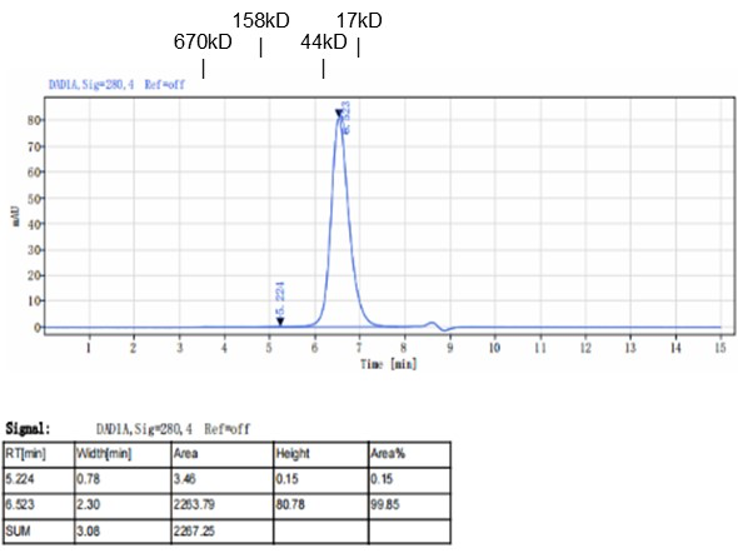His-mIL2(21-169)
Description
Interleukin-2 (IL2) is a cytokine secreted by activated CD4+ helper T-cells, and to a lesser extend, activated CD8+ T-cells and natural killer (NK) cells. It plays pivotal roles in the immune response and tolerance mechanisms. IL2 binds to either the high-affinity trimeric IL2R (IL2RA/CD25, IL2RB/CD122 and IL2RG/CD132) or the low-affinity dimeric IL2R (IL2RB and IL2RG). This interaction with the receptor complex leads to oligomerization and conformation changes in the IL2R subunits, resulting in downstream signaling starting with phosphorylation of JAK1 and JAK3. In turn, JAK1 and JAK3 phosphorylate the receptor, to form a docking site for the phosphorylation of several substrates including STAT5. This process leads to activation of several pathways including STAT, PI3K and MAPK. IL2 functions as a T-cell growth factor and can increase NK-cell cytolytic activity as well. It is well-known for its autocrine and paracrine activity on T cells, drives resting T cells to proliferate and induces IL2 and IL2Ra synthesis. IL2 plays a essential role in regulating the adaptive immune system by controlling the survival and proliferation of regulatory T-cells (T-Regs). After exiting from the thymus, T-Regs prevent other T cells from recognizing and reacting against self antigens, which could result in autoimmunity. T-Regs do so by preventing the responding cells from producing IL2. Thus, IL2 is required to discriminate between self and non-self, another unique characteristic of the immune system. IL2 is frequently used for the proliferation, differentiation, and increased antibody secretion of B cells as they transform into plasma cells in vitro. It is also classically used for the expansion of NK cells, early differentiated T cells and effector memory Treg cells during adoptive cell transfer cancer immunotherapy.
Product name | His-mIL2(21-169) |
Species | Mus musculus |
Expression system | HEK293 |
Buffer | PBS, pH 7.4 |
Delivery condition | Dry ice (-80°C) |
Delivery Time | 1 week if in stock; 4 weeks if production needed |
Storage condition | Store at -80°C |
Brand | BioMetas |
Applications | AIDS/HIV, Allergy Research, Cancer Biomarkers, Cancer Immunotherapy, Cancer Research, CAR-T Cell, Cell Culture, Diabetes/Weight Regulation, Immune Checkpoint, Immune System, Immunotherapy, Infectious Diseases, Inflammation Research, Neurobiology Research, Neuroinflammation, Stem Cells & Differentiation, Targeted Therapy, Transplantation Research, Wound Healing |
Aliases/Synonyms | IL-2, T-cell growth factor (TCGF), lymphokine, aldesleukin, Proleukin® |
Reference | |
Note | For research use only. Not suitable for clinical or therapeutic use. |
Size | 1mg, 5mg, 10mg, 50mg, 100mg |
Brand | BioMetas |
Product type | Cytokine |
Expression system | HEK293 |
Applications | AIDS/HIV, Allergy Research, Cancer Biomarkers, Cancer Immunotherapy, Cancer Research, CAR-T Cell, Cell Culture, Diabetes/Weight Regulation, Immune Checkpoint, Immune System, Immunotherapy, Infectious Diseases, Inflammation Research, Neurobiology Research, Neuroinflammation, Stem Cells & Differentiation, Targeted Therapy, Transplantation Research, Wound Healing |
Contact Us for a Quote!
Data Gallery
Fig. 1.) 4-20% SDS-PAGE analysis
Recombinant protein was visualized by Coomassie Brilliant Blue R250 staining.

Fig. 2.) SEC-HPLC analysis
Column: Superdex 200 Increase 5/150 GL
Running buffer: 2xPBS, pH 7.4
